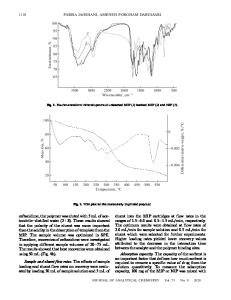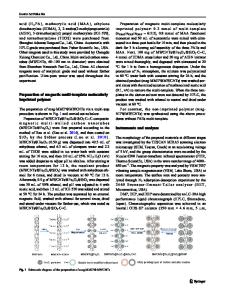Chitosan-based magnetic molecularly imprinted polymer: synthesis and application in selective recognition of tricyclazol
- PDF / 2,169,210 Bytes
- 14 Pages / 595.276 x 790.866 pts Page_size
- 69 Downloads / 368 Views
ORIGINAL RESEARCH
Chitosan‑based magnetic molecularly imprinted polymer: synthesis and application in selective recognition of tricyclazole from rice and water samples Namrata Laskar1 · Debabrata Ghoshal1 · Suman Gupta1 Received: 1 June 2020 / Accepted: 7 October 2020 © Iran Polymer and Petrochemical Institute 2020
Abstract A tricyclazole selective chitosan/Fe3O4 magnetic molecularly imprinted polymer (MMIP) was synthesized using non-covalent binding polymerization involving methacrylic acid (MAA) as functional monomer, divinylbenzene (DVB-80) as crosslinker, 2,2’-azobisisobutyronitrile as initiator, acetonitrile/toluene (75:25, v/v) as porogenic solvent and tricyclazole as template. Surface morphology and magnetic characterization of the prepared imprinted and non-imprinted polymers were done using scanning electron microscopy, transmission electron microscopy, Fourier transform infrared spectrometry and vibrating sample magnetometry, respectively. The adsorption kinetic data fitted best in pseudo-second-order model. The adsorption equilibrium was achieved in 30 min and the maximum binding capacity was 4579.9 µg/g. The Freundlich isotherm model was found suitable for explaining the binding isotherm data (R2 > 0.99). Negative values of thermodynamic parameters ∆G (Gibb’s free energy), ∆H (enthalpy), and ∆S (entropy) revealed exothermic and spontaneous nature of adsorption processes. It also revealed decreased randomness at the solid–liquid interface during sorption. The scatchard plot analysis suggested heterogeneity of binding sites on MMIPs. The molecular recognition selectivity of MMIPs towards tricyclazole was much higher, as compared to its structural analogues, tebuconazole (α = 28.58) and hexaconazole (α = 37.16). The MMIPs were successfully applied to separate and enrich tricyclazole from fortified samples of rice and water, with a recovery percentage of 89.4% and 90.9%, respectively. These reusable imprinted polymers possessing high selectivity and specificity can be utilized as an adsorbent for solid-phase extraction in sample preparation for tricyclazole residue analysis in complex environmental matrices. Keywords Chitosan · Fe3O4 MMIPs · Molecular imprinting · Tricyclazole · Binding selectivity · Solid-phase extraction
Introduction Tricyclazole (5-methyl-1,2,4-triazolo [3,4-b] benzo-thiazole) is a systemic fungicide, effective against blast disease (Pyriculariaoryzae) of rice. It interferes with the appressorial function of fungus by inhibiting melanin biosynthesis and host penetration [1]. In India, 75% WP formulation of tricyclazole is registered to control blast disease of rice. From the last few years, difficulties have arisen in the export of basmati rice from India to different countries (USA, EU and Iran) owing to the detection of the residue of pesticides * Suman Gupta [email protected] 1
Division of Agricultural Chemicals, Indian Agricultural Research Institute, New Delhi 110012, India
including tricyclazole exceeding the prescribed maximum residue limits (MRLs) [2]. The maxi
Data Loading...











